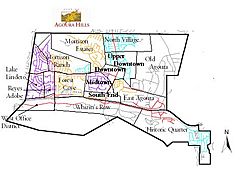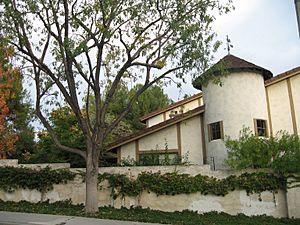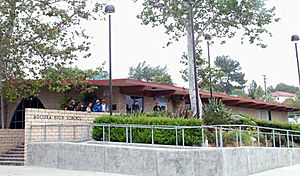Agoura Hills, California facts for kids
Quick facts for kids
Agoura Hills, California
|
|
|---|---|
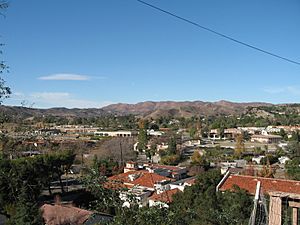
View of Agoura Hills looking from southern edge of the Historic Quarter in December 2006
|
|
| Motto(s):
"The Gateway to the Santa Monica Mountains"
|
|
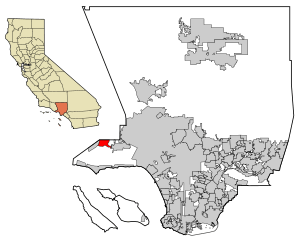
Location of Agoura Hills in Los Angeles County
|
|
| Country | United States |
| State | California |
| County | Los Angeles |
| Settled (by the Spanish) | 1700s |
| Incorporated | December 8, 1982 |
| Named for | Don Pierre Agoure |
| Government | |
| • Type | City Council/City Manager |
| Area | |
| • Total | 7.82 sq mi (20.25 km2) |
| • Land | 7.80 sq mi (20.19 km2) |
| • Water | 0.02 sq mi (0.06 km2) 0.37% |
| Elevation | 922 ft (281 m) |
| Population
(2020)
|
|
| • Total | 20,299 |
| • Density | 2,603.77/sq mi (1,005.37/km2) |
| Time zone | UTC−8 (Pacific Time Zone) |
| • Summer (DST) | UTC−7 (PDT) |
| ZIP Codes |
91301, 91376, 91377
|
| Area code | 747/818 |
| FIPS code | 06-00394 |
| GNIS feature IDs | 1733436, 2409666 |
Agoura Hills is a city in the Santa Monica Mountains region of Los Angeles County, California. Its population was 20,330 at the 2010 census, which decreased to 20,299 in 2020. It is in the eastern Conejo Valley between the Simi Hills and the Santa Monica Mountains. The city is in western Los Angeles County and is bordered to the north by Ventura County. It is 35 miles (56 km) northwest of Downtown Los Angeles and less than 10 miles (16 km) west of the Los Angeles city limits at Woodland Hills. Agoura Hills and unincorporated Agoura sit next to Calabasas, Oak Park, and Westlake Village.
Contents
History
The area was first settled by the Chumash Native Americans around 10,000 years ago. As the Alta California (Upper California) coast was settled by Spanish Franciscan missionaries in the late 18th century, the El Camino Real (the Royal Road or King's Highway), a road from Loreto, Baja California, Mexico to Sonoma, California, and connecting the Spanish missions in California, was established through the heart of what would later be known as Agoura Hills.
In about 1800, Miguel Ortega was granted a Spanish grazing concession called Rancho Las Virgenes or El Rancho de Nuestra Señora La Reina de Las Virgenes. The grant was abandoned after Ortega's death in 1810, and José Maria Dominguez was given Rancho Las Virgenes as a Mexican land grant in 1834. Maria Antonia Machado de Reyes purchased the rancho from Dominguez in 1845. (The "Reyes Adobe" ranch headquarters sits today in central Agoura Hills, where it is part of the Reyes Adobe Museum built around 2004 and owned by the Los Angeles County Parks and Recreation Department.)
By 1900, Agoura Hills was being used as a popular stage stop for travelers along the Camino Real because of its natural spring at the foothills of Ladyface Mountain, one of Agoura Hills' defining geographic features.
In the 1920s, the community was briefly known as Picture City, as Paramount Pictures owned a ranch known as Paramount Ranch used for filming Westerns. To obtain a post office of their own, the residents were required to choose a one-word name, and in 1927 chose the shortest name proposed: a misspelling of the last name of Pierre Agoure, a local Basque man and French immigrant who had settled in the area in 1871 to live the lifestyle of the Mexican rancher. Styling himself Don Pierre Agoure, he was a successful sheep herder and had a reputation as a swashbuckler.
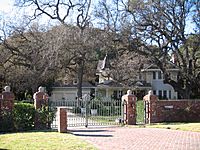
Agoura Hills began to grow in the late 1960s after the Ventura Freeway section of U.S. Route 101 was built through the city's heart, isolating its northern half from its south. The first housing tracts in Agoura were Hillrise, Liberty Canyon and Lake Lindero. Rapid growth continued during the 1970s, when schools were built and much of downtown erected.
In 1978, residents of the Agoura Hills area banded together to lobby Sacramento to widen the Kanan Bridge. Legislation was passed requiring the State Department of Transportation to award contracts for widening of the Kanan Road bridge overpass, over the Ventura Freeway, from two lanes to four lanes.
In 1982, the residents of the City of Agoura Hills voted in favor of cityhood by a 68% majority. Agoura Hills became the 83rd City in Los Angeles County. Elected to the first City Council were Mayor Fran Pavley, Mayor Pro Tem Carol Sahm, Councilmembers Ernest Dynda, John Hood, and Vicky Leary. Incorporating a year after neighboring Westlake Village, the drive for cityhood in the region was largely based on public discontent with the county's failure to limit residential development of the area, motives that influenced Malibu and Calabasas to follow suit in 1991.
The 1980s was a period of tremendous growth, with large land areas being subdivided into housing tracts and a great wave of migration of people into the city. In the 1990s, numerous businesses set up shop in the city, and downtown filled with shops and restaurants.
Geography
According to the United States Census Bureau, the city has a total area of 8.2 square miles (21 km2). 8.2 square miles (21 km2) of it is land and 0.04 square miles (0.10 km2) of it (0.37%) is water
Agoura Hills has a mountain called Ballard Mountain named after pioneer settler and freed slave John Ballard. The name of the mountain was officially changed from Negrohead to Ballard in a ceremony on February 20, 2010. Ladyface mountain is another prominent mountain on the west side of the Conejo Valley and stands at 2,031 feet high.
Agoura Hills is called the "Gateway to the Santa Monica Mountains National Recreation Area". The city is unofficially divided into a number of varied districts centered on the modern Downtown area of the city. The most notable of these districts include Morrison Ranch, Downtown, Forest Cove, South End, Malibu Junction, East Agoura, and Old Agoura.
Music
Agoura Hills is known regionally for its live music scene and originality in the nu metal scene, a fame that has given rise to such acts as Linkin Park, Foxygen, Dub Thompson, Skye Aspen, Incubus, Hoobastank, and Fort Minor.
This music scene was born amid the coming of age of the children of the first wave of migration into Agoura Hills, those that settled in the 1960s. The 1980s was the first boom in the music scene, but by the late 1980s, as many of these original rockers moved off to college or aged, the scene declined.
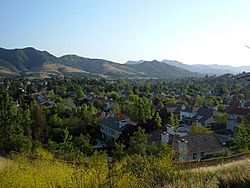
However, in the mid-1990s the music scene began to take off again, energized by the coming of age of the children of those who had settled in the early 1980s. The 1996 Jimmy Farris murder case (popularized by defendant Brandon Hein) spurred many city leaders to action in promoting the arts among teenagers, hoping to ward off a rising crime wave. This patronage helped re-popularize live music among teenagers, and created the fertile ground that led to the take off of Linkin Park and Hoobastank.
However, by the first decade of the 21st century, much of this wave of teenagers had aged or gone to college, leaving the scene with only a shell of the energy it once had. Although the scene lives on, pushed forward by various Battle of the Bands competitions and garage concerts, the lack of a third major wave of migration to Agoura Hills (construction having been relatively maxed out in the second migration) makes a major renaissance seem doubtful as of early 2007. Demographic data suggests a possible resurgence within the coming years, but current data shows that the majority of young people in the city are in the 10 to 14 years old age group, leaving a comeback to some years in the future.
As a result of this decline, it has become equally common to hear alt-rock blaring from stereos in Agoura as to hear reggaeton, a fact evidenced by radio station Latino 96.3's advertising campaign and runaway popularity in Agoura Hills.
Agoura Hills is home to The Canyon Club, a highly regarded concert venue that hosts national and regional touring acts such as Peter Frampton, Smash Mouth, Pat Benatar, Cyndi Lauper, REO Speedwagon, X, Steel Pulse, The New Cars, Asia, Boyz II Men, Alan Parsons, Foreigner, Bret Michaels and The Smithereens.
Demographics
| Historical population | |||
|---|---|---|---|
| Census | Pop. | %± | |
| 1990 | 20,390 | — | |
| 2000 | 20,537 | 0.7% | |
| 2010 | 20,330 | −1.0% | |
| 2020 | 20,299 | −0.2% | |
| U.S. Decennial Census | |||
2010
At the 2010 census Agoura Hills had a population of 20,330. The population density was 2,599.0 people per square mile (1,003.5/km2). The racial makeup of Agoura Hills was 17,147 (84.3%) White, (78.6% Non-Hispanic White), 267 (1.3%) African American, 51 (0.3%) Native American, 1,521 (7.5%) Asian, 24 (0.1%) Pacific Islander, 590 (2.9%) from other races, and 730 (3.6%) from two or more races. Hispanic or Latino of any race were 1,936 persons (9.5%).
The census reported that 20,242 people (99.6% of the population) lived in households, 15 (0.1%) lived in non-institutionalized group quarters, and 73 (0.4%) were institutionalized.
There were 7,327 households, 2,799 (38.2%) had children under the age of 18 living in them, 4,565 (62.3%) were opposite-sex married couples living together, 726 (9.9%) had a female householder with no husband present, 302 (4.1%) had a male householder with no wife present. There were 263 (3.6%) unmarried opposite-sex partnerships, and 36 (0.5%) same-sex married couples or partnerships. 1,346 households (18.4%) were one person and 438 (6.0%) had someone living alone who was 65 or older. The average household size was 2.76. There were 5,593 families (76.3% of households); the average family size was 3.15.
The age distribution was 4,904 people (24.1%) under the age of 18, 1,582 people (7.8%) aged 18 to 24, 4,465 people (22.0%) aged 25 to 44, 7,089 people (34.9%) aged 45 to 64, and 2,290 people (11.3%) who were 65 or older. The median age was 42.4 years. For every 100 females, there were 97.2 males. For every 100 females age 18 and over, there were 94.6 males.
There were 7,585 housing units at an average density of 969.7 per square mile, of the occupied units 5,715 (78.0%) were owner-occupied and 1,612 (22.0%) were rented. The homeowner vacancy rate was 0.5%; the rental vacancy rate was 6.8%. 16,111 people (79.2% of the population) lived in owner-occupied housing units and 4,131 people (20.3%) lived in rental housing units. The median household income was $107,885, according to the 2010 United States Census, with 7.1% of the population living below the federal poverty line.
2000
At the 2000 census there were 20,537 people in 6,874 households, including 5,588 families, in the city. The population density was 2,511.8 inhabitants per square mile (969.4/km2). There were 6,993 housing units at an average density of 855.3 per square mile (330.1/km2). The racial makeup of the city was 86.96% White, 1.32% Black or African American, 0.25% Native American, 6.50% Asian, 0.10% Pacific Islander, 2.09% from other races, and 2.78% from two or more races. 6.85% of the population were Hispanic or Latino of any race.
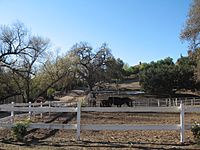
Of the 6,874 households 47.3% had children under the age of 18 living with them, 67.7% were married couples living together, 9.9% had a female householder with no husband present, and 18.7% were non-families. 13.8% of households were one person and 3.0% were one person aged 65 or older. The average household size was 2.98 and the average family size was 3.30.
The age distribution was 30.5% under the age of 18, 6.3% from 18 to 24, 27.6% from 25 to 44, 29.4% from 45 to 64, and 6.2% 65 or older. The median age was 38 years. For every 100 females, there were 99.1 males. For every 100 females age 18 and over, there were 94.0 males.
Events
Agoura Hills is home to the Great Race of Agoura Hills, an annual running event held at Chumash Park in Agoura Hills in March of every year. The Great Race was established in 1986 and features six races including Pacific Half (Half Marathon), Chesebro Half (Half Marathon), Old Agoura 10K, Deena Kastor (5 Kilometers), Kids 1 Mile, and the Family Fun Run (1 Mile). The Chesebro Half was voted Best Half Marathon in the U.S. in 2011.
Economy
Top employers
According to the city's 2020 Comprehensive Annual Financial Report, the top employers in the city are:
| # | Employer | # of Employees |
|---|---|---|
| 1 | Las Virgenes Unified School District | 468 |
| 2 | National Veterinary Associates, Inc. | 339 |
| 3 | Westlake Financial Services | 280 |
| 4 | PennyMac Financial Services | 264 |
| 5 | Teradyne | 205 |
| 6 | Nuance (Formerly Touch Commerce) | 143 |
| 7 | Motor Vehicle Software Corp/VITU | 132 |
| 8 | Wood Ranch | 115 |
| 9 | Cydcor LLC | 100 |
| 10 | Zebra Technologies | 96 |
Sports
Agoura Hills is the corporate headquarters of the Los Angeles Rams from 2016 to the 2022 season.
Events
Agoura Hills is home to the Great Race of Agoura Hills, an annual running event held at Chumash Park in Agoura Hills in March of every year. The Great Race was established in 1986 and features six races including Pacific Half (half-marathon), Chesebro Half (half-marathon), Old Agoura 10K, Deena Kastor (5 kilometers), Kids 1 Mile, and the Family Fun Run (1 mile). The Chesebro Half was voted best half-marathon in the U.S. in 2011.
Education
The Las Virgenes Unified School District serves Agoura Hills.
- Lindero Canyon Middle School
- Agoura High School
- Indian Hills High School
Infrastructure
Las Virgenes Water District serves Agoura Hills along with Westlake Village and other parts of western Los Angeles County. State water provided by the Metropolitan Water District of Southern California is the sole source used by the district.
The Los Angeles County Sheriff's Department (LASD) operates the Malibu/Lost Hills Station in Calabasas, serving Agoura Hills.
The United States Postal Service Agoura Hills Post Office is located at 5158 Clareton Drive.
Notable people
- Erin Brockovich, environmental activist
- Kirk Cameron, actor
- Brooke Candy, artist and musician
- Rob Chiarelli, multiple Grammy Award winner
- Guillermo del Toro, Mexican film director, lived in Agoura Hills for a few years before he moved to Toronto, Canada in 2015.
- Jason Falkner, musician
- Foxygen, band
- Chelsey Goldberg (born 1993), ice hockey player
- Ron Goldman, waiter and deceased friend of Nicole Brown Simpson
- Heather Graham, actress
- Johnny Gyro, seven-time karate world champion (owns studio in Oak Park, CA)
- Skip Hicks, former UCLA running back and NFL and CFL football player
- Warren Hill, jazz musician
- Deena Kastor, Olympic medalist/American marathon record holder
- Grant Kirkhope, composer
- Hayley Kiyoko, singer, songwriter, actress, and dancer
- Taylor Lautner, actor
- Linkin Park, band
- Mike Shinoda, musician from alternative rock group Linkin Park
- Brad Delson, musician from alternative rock group Linkin Park
- Casey Matthews, NFL linebacker for the Philadelphia Eagles
- Clay Matthews, NFL linebacker for the Green Bay Packers
- Tia Mowry, model and actress
- Harry Nilsson, singer-songwriter
- Terri Nunn, musician from new wave group Berlin, actress, radio host
- Rob Paulsen, voice actor
- Russell Peters, comedian
- Alisan Porter, actress, & singer, winner of 10th season of The Voice
- Doug Robb, singer from post-grunge group Hoobastank
- Ray Romano, comedian
- Todd Steussie, NFL offensive lineman
- Robert Stock (born 1989), Major League Baseball player
- Elias Toufexis, film, television and voice actor
- Jason Wade, singer and musician
- Rainn Wilson, film and television actor
- Matthew Wolff, professional golfer
- Mark L. Young, actor
See also
 In Spanish: Agoura Hills para niños
In Spanish: Agoura Hills para niños






